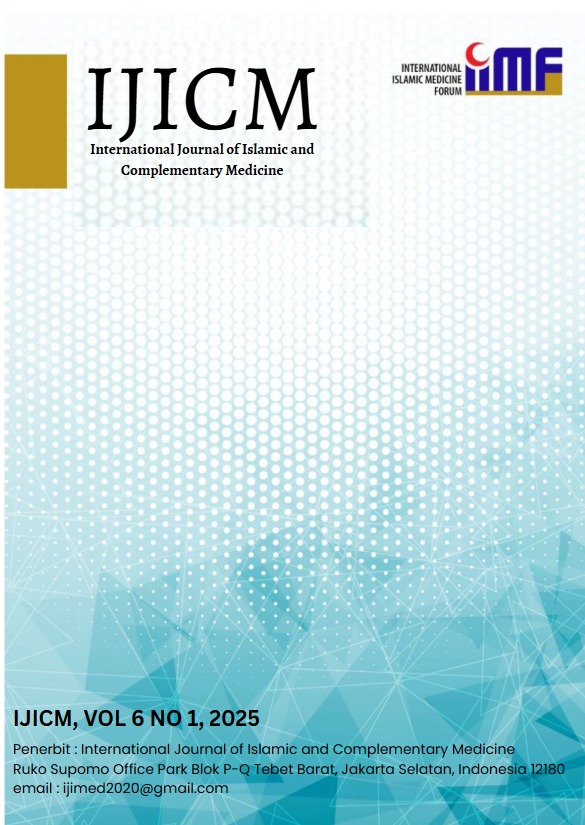UTILIZATION OF FIGS (F. carica L) FOR TREATMENT GASTROINTESTINAL DISEASES IN THE QUR’AN PERSPECTIVE AND SCIENCE
##plugins.themes.academic_pro.article.main##
Abstract
ABSTRAK
Indonesia secara global menempati urutan kedua 40,8% dengan angka kejadian gastrointestinal di Asia setelah India 43%. Buah tin atau dalam bahasa latin disebut juga Ficus carica merupakan sejenis buah yang berasal dari Asia Barat yang sangat terkenal dalam dunia Islam. Hal ini dikarenakan buah tin disebut oleh Allah SWT dalam firman Allah SWT dalam Al-Quran pada surat At-Tin yaitu surat ke-95. Menurut penelitian yang pernah dilakukan dengan pelarut etanol dan etilasetat buah tin terbukti banyak mengandung metabolit sekunder, salah satunya flavonoid. Flavonoid menunjukkan sejumlah sifat farmakologis di area GIT, bertindak sebagai agen antisekresi, sitoprotektif, dan antioksidan. Sifat antioksidan senyawa fenolik telah dipelajari secara luas, namun menjadi jelas bahwa mekanisme kerjanya melampaui modulasi stres oksidatif. Senyawa flavonoid juga telah dilaporkan memiliki peran yang bermanfaat dalam tukak lambung, karena flavonoid diduga merangsang pembentukan PGE 2. Semua bagian dari tanaman tin dapat dimanfaatkan dalam pengobatan herbal dan telah terbukti khasiatnya dalam menangani berbagai masalah. Buah tin dapat dikonsumsi segar dan kering oleh manusia. Buah tin yang matang dapat dimakan dimana memiliki kulit tebal dengan damaging buah yang manis yang terdiri dari biji-biji kecil dan memberikan rasa renyah yang halus saat dikunyah. Tujuan dari penyusunan artikel adalah untuk mengetahui pandangan tafsir tentang Surah At-Tin yang dapat digunakan pada penyakit gastrointestinal.
ABSTRACT
Indonesia Indonesia ranks second globally at 40.8% in gastrointestinal incidence in Asia, following India at 43%. (Farishal et al, 2018). The fig (Ficus Carica L) is a fruit that originated from West Asia and is very well known in the Islamic world, because it is mentioned in the word of God in surah At-tin 95 in the Quran. Research used ethanol and ethyl acetate solvents showed that figs contains many secondary metabolites, including flavonoids which have been used for centuries in traditional medicine for their health-promoting effects addressing gastrointestinal. Flavonoids have been pharmacological effects in the digestive tract, acting as antisecretory agents, cytoprotective agents, and antioxidants. The antioxidant properties of phenolic compounds have been extensively studied, but it has become clear that their mechanisms of action go beyond the modulation of oxidative stress. Flavonoid compounds have also been reported to play a beneficial role in gastric ulcers, as flavonoids are believed to stimulate the formation of PGE 2. All parts of the fig tree can be used as herbal medicine and have been proven to be effective in treating various problems. Figs (Ficus Carica L) can be consumed by humans both fresh and dried. Ripe figs have thick skin, the flesh of the small seeds is sweet and soft and crispy when cooked and chewed. This article review aims to know the interpretative views on Surah At-Tin that can be applied to gastrointestinal diseases.
##plugins.themes.academic_pro.article.details##

This work is licensed under a Creative Commons Attribution-ShareAlike 4.0 International License.
References
- Alara O.R., Abdurahman N.H., Ukaegbu C.I. Extraction of phenolic compounds: A review. Currr Res Food Sci. 2021; 4: 200–214. Published online 2021 Apr 2.
- Joseph S.Justin Raj. 2011. Pharmacognostic and phytochemical properties of Ficus carica Linn –An overview. IJPRIF ISSN : 0974-4304 Vol. 3, No.1, pp 08-12.
- Judha, S. 2012 . Teori pengukuran nyeri & nyeri .persalinan.Yogyakarta :Nuha Medika.
- Kementerian Kesehatan RI. 2018. Hasil Riset Kesehatan Dasar (Riskesdas) 2018. Jakarta: Badan Penelitian dan Pengembangan Kesehatan Kementerian RI.
- Lee K-M, Yeo M, Choue J-J, et al. Protective mechanism of epigallocatechin-3-gallate against Helicobacter pylori-induced gastric epithelial cytotoxicity via the blockage of TLR-4 signaling. Helicobacter. 2004;9:632–642
- Smith, GD, Watson, Roger. 2005 . Keperawatan Gastrointestinal. AS: Penerbitan Blackweel.
- Sukarmin, 2012. Keperawatan pada system pencernaan. Pustaka Pelajar Yogyakarta
- Suraya, M dan Anjeli, Y. 2022. Integrasi Ayat-Ayat Al-Qur'an Pada Teori Sistem Pencernaan Makanan. Journal of Development and Reseacrh in Education. 2 (2). 38-47.
- Sylvia. 2017. Buku Patologias : Penerbit Buku Kedokteran : EGC.

